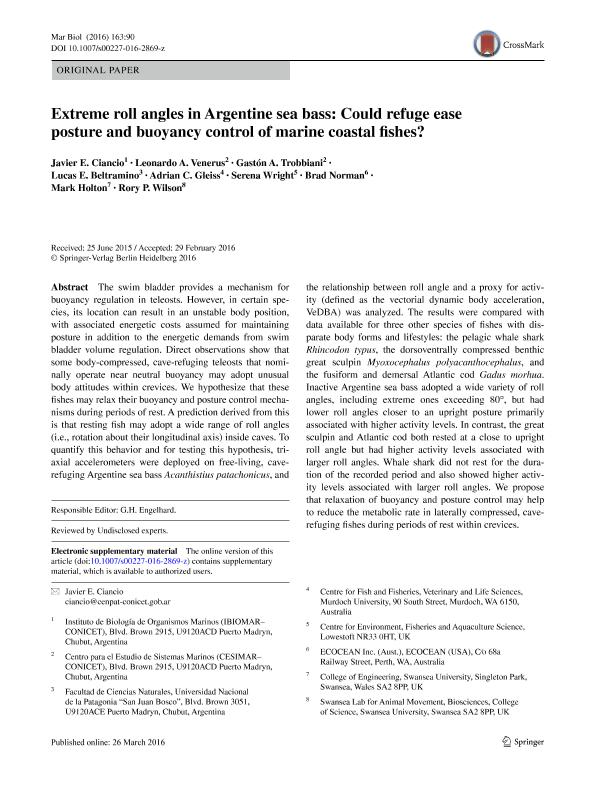Artículo
Extreme roll angles in Argentine sea bass: Could refuge ease posture and buoyancy control of marine coastal fishes?
Ciancio Blanc, Javier Ernesto ; Venerus, Leonardo Ariel
; Venerus, Leonardo Ariel ; Trobbiani, Gastón Andres
; Trobbiani, Gastón Andres ; Beltramino, Lucas Esteban
; Beltramino, Lucas Esteban ; Gleiss, Adrian C.; Wright, Serena; Norman, Brad; Holton, Mark; Wilson, Rory P.
; Gleiss, Adrian C.; Wright, Serena; Norman, Brad; Holton, Mark; Wilson, Rory P.
 ; Venerus, Leonardo Ariel
; Venerus, Leonardo Ariel ; Trobbiani, Gastón Andres
; Trobbiani, Gastón Andres ; Beltramino, Lucas Esteban
; Beltramino, Lucas Esteban ; Gleiss, Adrian C.; Wright, Serena; Norman, Brad; Holton, Mark; Wilson, Rory P.
; Gleiss, Adrian C.; Wright, Serena; Norman, Brad; Holton, Mark; Wilson, Rory P.
Fecha de publicación:
04/2016
Editorial:
Springer
Revista:
Marine Biology
ISSN:
0025-3162
Idioma:
Inglés
Tipo de recurso:
Artículo publicado
Clasificación temática:
Resumen
The swim bladder provides a mechanism for buoyancy regulation in teleosts. However, in certain species, its location can result in an unstable body position, with associated energetic costs assumed for maintaining posture in addition to the energetic demands from swim bladder volume regulation. Direct observations show that some body-compressed, cave-refuging teleosts that nominally operate near neutral buoyancy may adopt unusual body attitudes within crevices. We hypothesize that these fishes may relax their buoyancy and posture control mechanisms during periods of rest. A prediction derived from this is that resting fish may adopt a wide range of roll angles (i.e., rotation about their longitudinal axis) inside caves. To quantify this behavior and for testing this hypothesis, triaxial accelerometers were deployed on free-living, cave-refuging Argentine sea bass Acanthistius patachonicus, and the relationship between roll angle and a proxy for activity (defined as the vectorial dynamic body acceleration, VeDBA) was analyzed. The results were compared with data available for three other species of fishes with disparate body forms and lifestyles: the pelagic whale shark Rhincodon typus, the dorsoventrally compressed benthic great sculpin Myoxocephalus polyacanthocephalus, and the fusiform and demersal Atlantic cod Gadus morhua. Inactive Argentine sea bass adopted a wide variety of roll angles, including extreme ones exceeding 80°, but had lower roll angles closer to an upright posture primarily associated with higher activity levels. In contrast, the great sculpin and Atlantic cod both rested at a close to upright roll angle but had higher activity levels associated with larger roll angles. Whale shark did not rest for the duration of the recorded period and also showed higher activity levels associated with larger roll angles. We propose that relaxation of buoyancy and posture control may help to reduce the metabolic rate in laterally compressed, cave-refuging fishes during periods of rest within crevices.
Palabras clave:
Roll Angle
,
Accelerometer
,
Acanthistius Patachonicus
,
Whale Shark
Archivos asociados
Licencia
Identificadores
Colecciones
Articulos(CCT-CENPAT)
Articulos de CTRO.CIENTIFICO TECNOL.CONICET - CENPAT
Articulos de CTRO.CIENTIFICO TECNOL.CONICET - CENPAT
Articulos(IBIOMAR)
Articulos de INSTITUTO DE BIOLOGIA DE ORGANISMOS MARINOS
Articulos de INSTITUTO DE BIOLOGIA DE ORGANISMOS MARINOS
Citación
Ciancio Blanc, Javier Ernesto; Venerus, Leonardo Ariel; Trobbiani, Gastón Andres; Beltramino, Lucas Esteban; Gleiss, Adrian C.; et al.; Extreme roll angles in Argentine sea bass: Could refuge ease posture and buoyancy control of marine coastal fishes?; Springer; Marine Biology; 163; 4; 4-2016; 1-11
Compartir
Altmétricas



